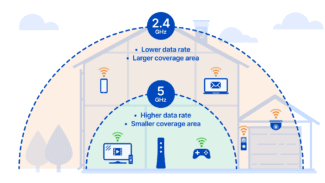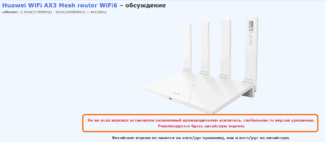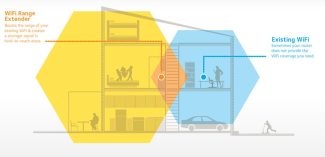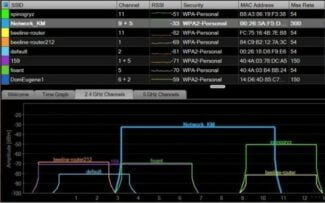Keep in mind that the maximum speeds given for each technology are only the upper theoretically achievable threshold. That is, they are only possible when the access point is working in ideal "laboratory" conditions with no external interference. In practice, even under favorable conditions, the actually attainable transmission speed may be from one-third to half of the maximum speed specified in the standard.
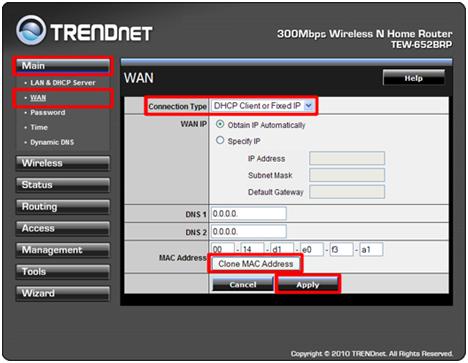
Powerful wifi router
The range of a wifi router depends on the type of router or access point used. Factors that determine the range of the router (access point) are:
- total transmitter power;
- The type of 802.11 protocol used;
- The length and attenuation of the cables connected to the antenna;
- Obstacles and interference in the signal path in a given room;
- The gain of the router's antennas.
Range of wifi router standard 802.11g, with a regular antenna (gain about 2dBi) is about 150m in the open country and indoors – 50 m. But brick walls and metal structures can reduce this range by 25% or more. 802.11a uses higher frequencies than 802.11b/g, so it is more sensitive to various obstacles. In addition, the range of 802.11b or 802.11g Wi-Fi networks is greatly affected by microwave oven interference. Tree foliage is also a strong obstacle because it contains water, which absorbs the microwave radiation of the band in use. For example, heavy rain weakens the signal in the 2.4GHz band to 0.05 dB/km, thick fog – 0.02 dB/km, and the forest (dense foliage, branches) – up to 0.5 dB/meter.
Having chosen a Wi-Fi router, the range can be roughly calculated using a special calculator, which is located below, it is designed for D-Link equipment, but the formulas and methodology used there will be suitable for any other.
If you create a radio bridge between two networks, you must take into account that the space around the straight line from the receiver to the transmitter must be free of
absorbing and reflecting obstacles in a radius equal to 0.6 of the radius of the first Fresnel zone. The size of this zone can be calculated by the following formula:

Powerful Wi-Fi router
If you choose a powerful router, its range and reception quality should satisfy your requirements.
The power of a wifi router is largely determined by the power of the signal boosters in it.
A powerful router based on the Realtek 8187L chipset not only has a high power of 1 watt, but also a large-scale support. The drivers of this chipset are supported by all operating systems. If you use an external optional antenna, the distance can be up to 5 km.
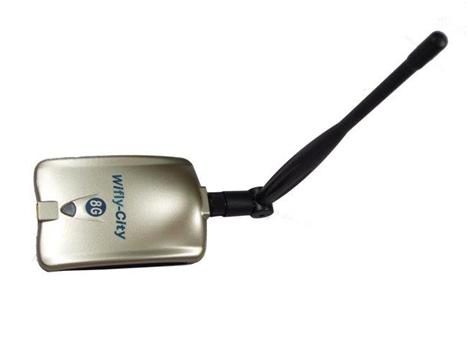
Rasprostranenye brands Alfa, NEtsys, Senao EnGenius EUB Ext High-Power, Wifly city 8G , 20G , AIRLIVE, G-Sky GS-27USB-50, KASENS.
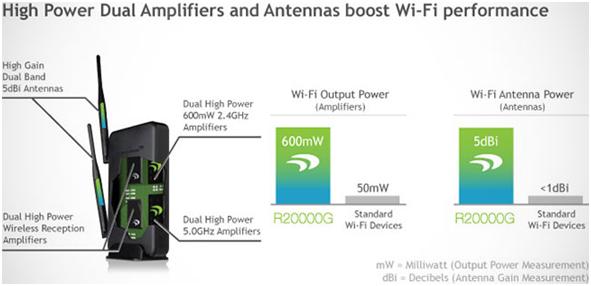
Amped Wireless has released its most powerful router, the R20000G High Power Wireless-N, which features 600-mW signal amplifiers in the 2.4 GHz band.
The R20000G is capable of operating on two networks: 5,000 MHz and 2,400 MHz. Router provides indoor coverage up to 930 square meters. Two powerful antennas with 5 dB/inch of gain are connected to the router, but they can be replaced with more powerful antennas.
RF Wireless World
This page covers WLAN range calculator or wifi range calculator. This WLAN range calculator takes frequency, transmit power, receiver sensitivity, antenna gains, fade margin as inputs and provides coverage range as output. The formula for this wifi range calculator is also mentioned.
EXAMPLE Values for this WLAN range calculator or WiFi range calculator:
INPUTS:
Frequency(MHz) = 2450 MHz ; Transmit power= 20 dBm ; Receiver sensitivity= -100dBm ; Transmit Antenna Gain = 6 dBi ; Receiver Antenna Gain = 6 dBi ; Fade Margin = 12 dB ; cable loss = 0; Other Losses = 0
OUTPUTS:
Maximum Path Loss =120 dB WLAN/WiFi coverage range = 9.746 Km
WLAN Range Formula | WiFi Range Formula or Equation
Following formula or equation is used for this WLAN range calculator/WiFi range calculator.
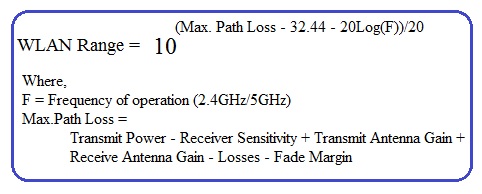
Refer following link on electronic design website for explaination of the above formula/equation used for this calculator.
https://electronicdesign.com/communications/understanding-wireless-range-calculations
Исходные данные.
- Мощность передатчика Pt,дБм = 16 дБм
- Коэффициент усиления штатной антенны передатчика Gt,дБи = 3 дБи.
- Gain of the standard receiver antenna Gr,dBi = 1 dBi. Let's determine the total gain of the transmission system by formula (4).
Using formula (3) we will determine the free space losses.
Central bandwidth of the combined 40 MHz channel (36 +40) according to Table 3 will be equal to

Order of operation:
"half-channels"-the 40 MHz channel they form in conjunction with the next highest order 20 MHz channel.
Variants of assignment (are indicated according to number of the student в journal)
D=10 ((60-33)/20)-lg2437 =0.009186 km≈ 9 m
48Mbit/с
D=10 ((94-33)/20)-lg2417 =0,4642 km≈ 464 m
The values for channel 2(10)
- For technology 802.11n (5 GHz) for each of the given 40 MHz channelscalculaterangesworkforallpossiblespeedstransfer rates(table4).
D=10 ((81-33)/20)- lg 5450 =0.0461 km≈ 46 m
channel 1(56) value
D=10 ((81-33)/20)- lg 5280 =0.0476 km≈ 48 m
value of channel 2(124)
The 5 GHz band provides less coverage than the 2.4 GHz band, but the data rate is higher.
Read More:
